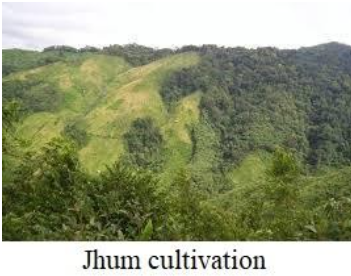
What is jhum cultivation and where it is followed in India?
Answer
569.1k+ views
Hint:Slash-and-burn is an agrarian method that includes the cutting and consuming of plants in backwoods or forests to make fields. It is food horticulture that commonly utilizes little innovation. It is commonly key in moving development agribusiness.
Complete answer:
Jhum or Jhoom development is an extraordinary name for slice and consume horticulture followed by the ancestral gatherings in the north eastern conditions of India like Arunachal Pradesh, Meghalaya, Mizoram and Nagaland and furthermore in the locale of Bangladesh like Khagrachari and Sylhet. To follow moving agribusiness (jhum), the land is cleared by consuming the vegetation, is developed for quite a while, and afterward is deserted for another site when the efficiency of the dirt decays.
This framework includes freeing a piece from land by setting fire or clear felling and utilizing the zone for developing harvests of horticultural significance, for example, upland rice, vegetables or natural products. After a couple of cycles, the land loses fruitfulness and another zone is picked. Slice-and-consume horticulture, additionally called fire-decrepit cultivation, is a cultivating strategy that includes the cutting and consuming of plants in a backwoods or forest to make a field called a swidden.
After around three to five years, the plot's efficiency diminishes because of exhaustion of supplements alongside weed and nuisance attack, making the ranchers relinquish the field and move over to another zone. The time it takes for a swidden to recoup relies upon the area and can be as meagre as five years to over twenty years, after which the plot can be sliced and consumed once more, rehashing the cycle. In India, the training is known as jhum or jhoom.

Note: First and preeminent is the renewal of soil. It enables the dirt to restore all the supplements it has lost during the development. The reusing cycle enables the characteristic vegetation to develop back and this is what is actually required for the dirt. During rainstorms, seeds are planted in remains, crop is developed for couples of years in pivot and after this, crops get collected.
Complete answer:
Jhum or Jhoom development is an extraordinary name for slice and consume horticulture followed by the ancestral gatherings in the north eastern conditions of India like Arunachal Pradesh, Meghalaya, Mizoram and Nagaland and furthermore in the locale of Bangladesh like Khagrachari and Sylhet. To follow moving agribusiness (jhum), the land is cleared by consuming the vegetation, is developed for quite a while, and afterward is deserted for another site when the efficiency of the dirt decays.
This framework includes freeing a piece from land by setting fire or clear felling and utilizing the zone for developing harvests of horticultural significance, for example, upland rice, vegetables or natural products. After a couple of cycles, the land loses fruitfulness and another zone is picked. Slice-and-consume horticulture, additionally called fire-decrepit cultivation, is a cultivating strategy that includes the cutting and consuming of plants in a backwoods or forest to make a field called a swidden.
After around three to five years, the plot's efficiency diminishes because of exhaustion of supplements alongside weed and nuisance attack, making the ranchers relinquish the field and move over to another zone. The time it takes for a swidden to recoup relies upon the area and can be as meagre as five years to over twenty years, after which the plot can be sliced and consumed once more, rehashing the cycle. In India, the training is known as jhum or jhoom.

Note: First and preeminent is the renewal of soil. It enables the dirt to restore all the supplements it has lost during the development. The reusing cycle enables the characteristic vegetation to develop back and this is what is actually required for the dirt. During rainstorms, seeds are planted in remains, crop is developed for couples of years in pivot and after this, crops get collected.
Recently Updated Pages
Master Class 12 English: Engaging Questions & Answers for Success

Master Class 12 Social Science: Engaging Questions & Answers for Success

Master Class 12 Chemistry: Engaging Questions & Answers for Success

Which is the Longest Railway Platform in the world?

India Manned Space Mission Launch Target Month and Year 2025 Update

Which of the following pairs is correct?

Trending doubts
What are the major means of transport Explain each class 12 social science CBSE

Which are the Top 10 Largest Countries of the World?

Draw a labelled sketch of the human eye class 12 physics CBSE

How much time does it take to bleed after eating p class 12 biology CBSE

Explain sex determination in humans with line diag class 12 biology CBSE

Plot a graph between potential difference V and current class 12 physics CBSE




